This is the second post in the Travel Highlights series sharing some of the most enduring highlights of all our travels.
Guelaguetza Festival, Oaxaca, Mexico:
The dancers don’t walk, they dance,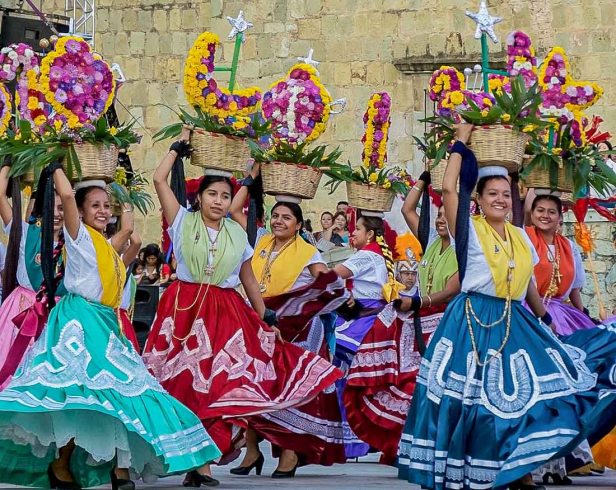
in a long parade, non-stop for about two hours, each accompanied by their own brass band. It’s a crowded joyous melee. Every now and then someone yells out Viva Oaxaca! and the crowd responds Viva Oaxaca!, and then Viva Guelaguetza! and the crowd responds Viva Guelaguetza!, and Viva Mexico! It’s so much fun. The streets are packed on either side, and in the middle the musicians are playing to beat the band, and the dancers are dancing their hearts out.
For ten days we were immersed in the dancing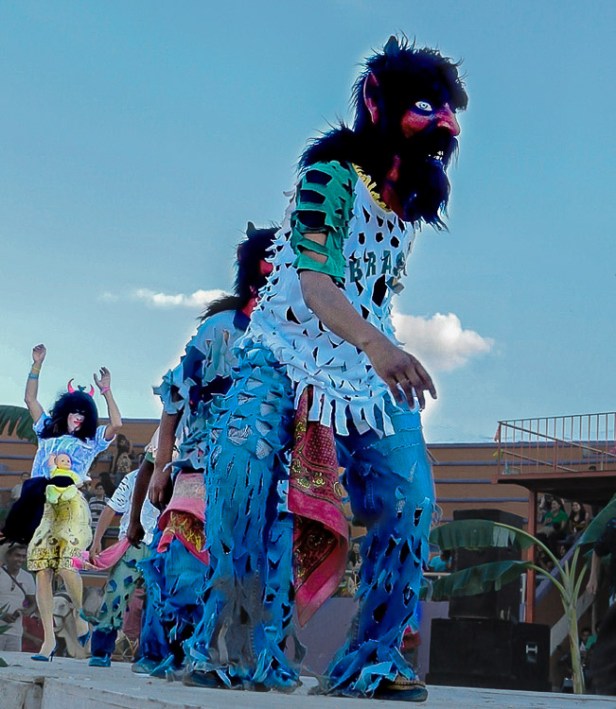
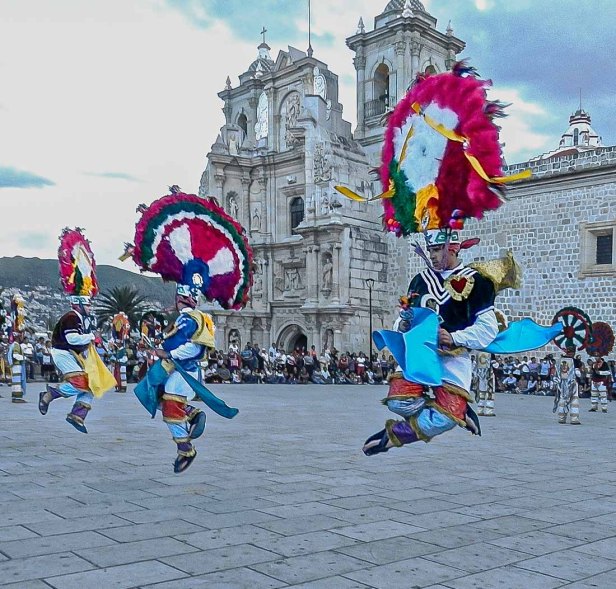
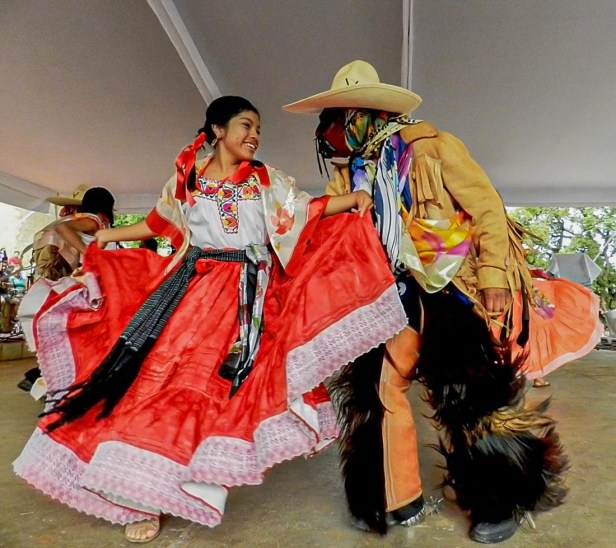
and music of Guelaguetza, a festival of the indigenous people of Oaxaca. They present their traditional dances, music, costumes
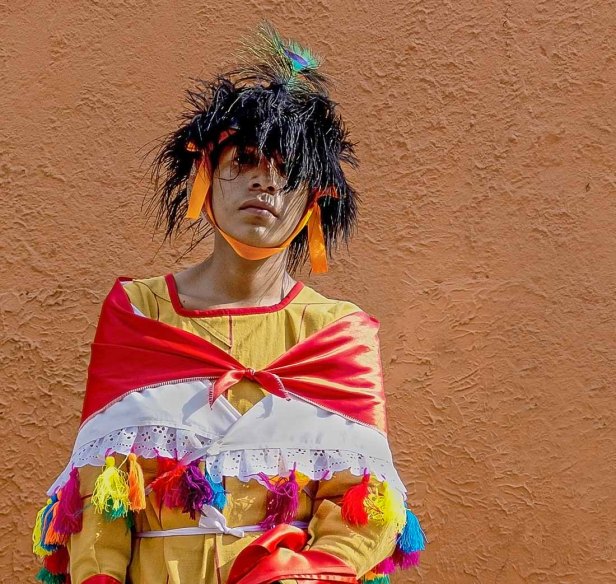
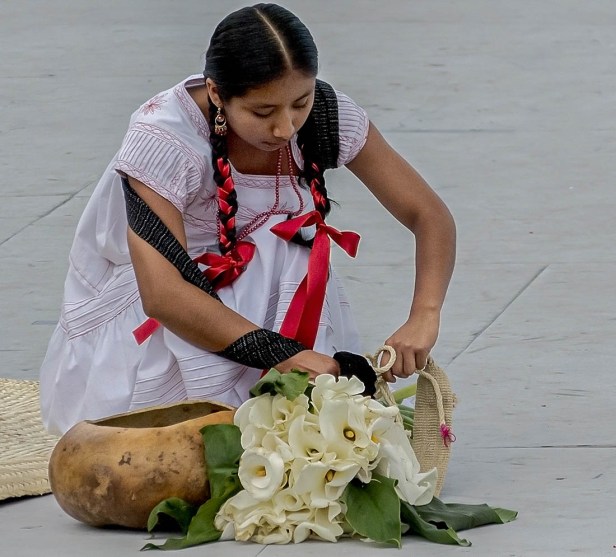
and food. It’s a wild party where their cultural traditions are affirmed, deepened, shown to each other and the world, and madly celebrated. It’s about maintaining and sharing their traditions, and about gifting. After every dance performance gifts are thrown to the crowd, ranging from tiny woven corn-sheaf artifacts, to traditional pastries, to small plastic bottles of mescal, to pineapples. Yes pineapples. Beware the flying pineapples! Imagine one hundred dancers in a line coming at you at a fast trot, then weaving in and out, waving their pineapples in the air, and at the end of the dance hurling the pineapples into the crowd! I’m not joking.
There are several daily dance performances, a food festival, a mescal festival, a mushroom festival, puppet performances, two large parades, performances by the State Traditional Folk Ballet company,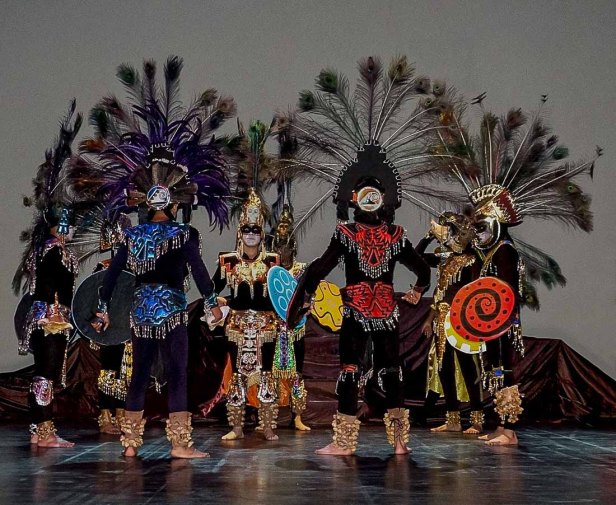
four four-hour performances at a sold-out stadium seating ten thousand,
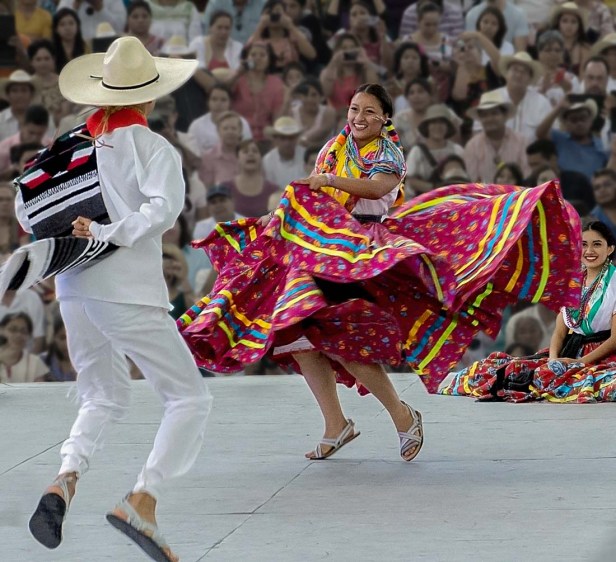
a competition for the Corn Princess, a mole (sauce) festival, two dance/pageant performances of a key piece of Oaxacan history at the again sold-out stadium,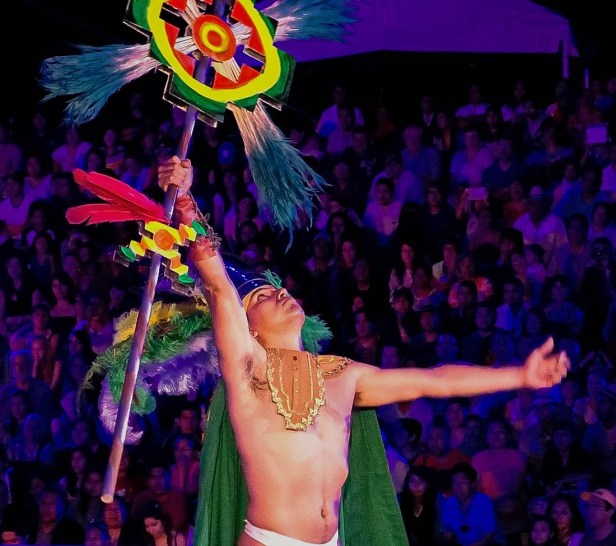
and much more. It is popular with foreign tourists, and even more so with Mexican tourists who come from all over the country.
For two weeks every July (pre-pandemic, and presumably post) the entire state of Oaxaca celebrates, and everyone is invited to the party. Pure magic. You can read more about our experience of Guelaguetza by following these four links.
Pushkar Camel Fair, Pushkar, India:
The Pushkar Camel Fair is an annual livestock fair and Hindu pilgrimage. At its core this is not a touristy event; both the enormous livestock fair and the religious rituals have been taking place in this way for hundreds of years.
Thousands of people and animals descend on the town from all over the Thar Desert. They come to buy, sell and trade their livestock. An entire tent village of thousands springs up in a matter of days in a huge dusty field next to a stadium, next to the town. Those who come range from villagers with a few cattle or camels to sell, to the elite of the elite selling Marwari horses for $10,000 or more. We are told that a really good camel goes for about $50,000.
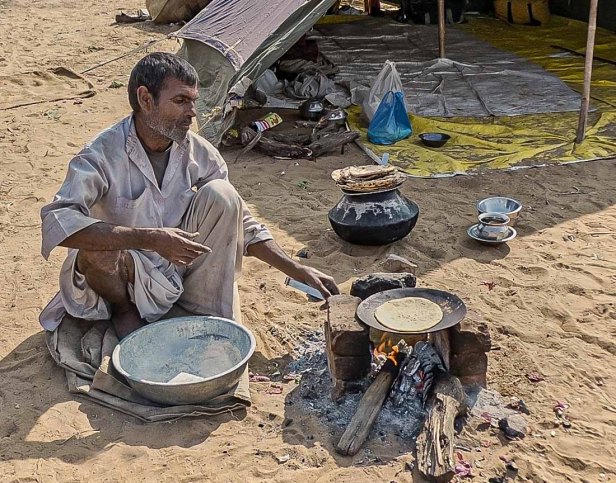
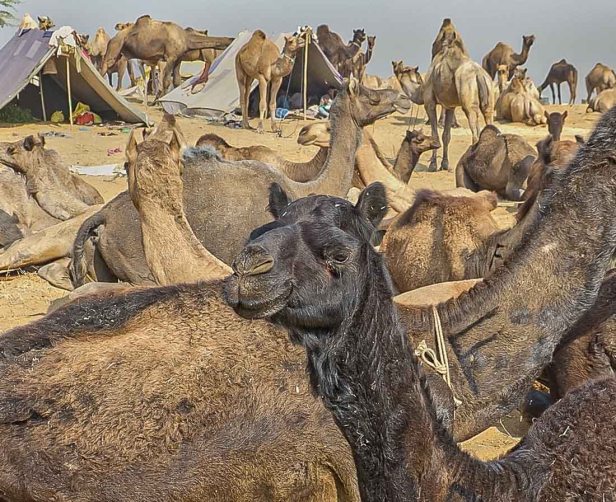
The gathering attracts about 30,000 animals and their owners, and about 300,000 people. Tourists come from all over, at least as many from India as from other countries. It’s a huge carnival – a livestock trading fair, plus games, cricket matches, camel decorating and camel dancing competitions,
horse judging, performances, a midway and a circus, and an important religious ritual all rolled into one.
Pushkar is a Hindu holy town and religious ceremonies are held every day. One day there’s a procession of flower-bedecked cars and vans, a big silver wedding chariot pulled by a white horse, a marching band, and at the rear a camel chariot and in the back this couple dressed as Hindu gods.
There are devoted ash-covered holy men.
There are dance performances at the temples. There’s a huge Hare Krishna wooden elephant-on-wheels, being ridden by “someone special”, the whole thing accompanied by amplified chanting, and by hundreds of people, as it rolls slowly around the large courtyard of a temple.
The camel race. Wooooohooooo! What a wild rush that is. One camel runs off in the wrong direction. One loses its rider. Most of them bump into each other. Some go in a big circle around the stadium, some in a much smaller circle. Some go in any old direction at all. My ordered Virgo mind wants a properly organized race, with a track, and a starting line and everything. Clearly I’m in the wrong country for that. Wild fun! I have no idea how they determine the winner.
At both the opening and closing ceremonies hundreds of school girls, in bright colourful traditional dress fill the stadium with their dancing. Hundreds of them. All dancing together. Flashing eyes, flying feet, waving arms, curling fingers, swirling dresses, pounding rhythms, and flying dust. Spectacular!
Our nine days in Pushkar during the annual camel fair was an extraordinary and unforgettable time. If you ever have the chance go. Just go. Check out the tent city of thousands. See the throngs of people coming from all over India
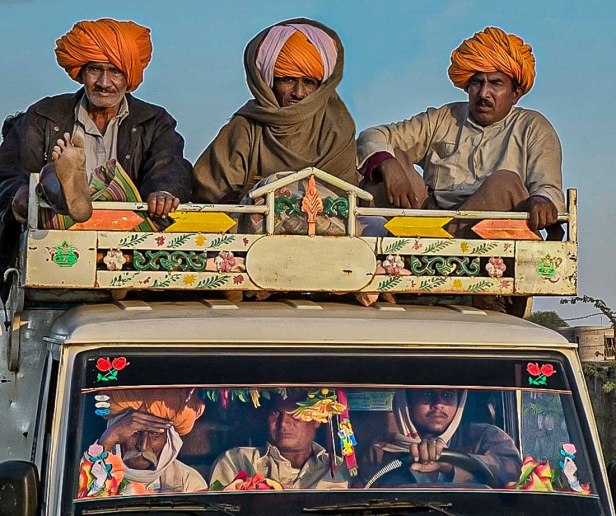
cramming the town and the stadium. Go into the temples and to some of the religious ceremonies, go to the crazy competitions, see the exquisite temple dancers, and the closing parade.

Just go. It’s exciting and exhausting and enriching and a big piece of joy all rolled into one. The best fun ever!
The Pushkar Camel Fair is held every year during the Hindu month of Kartik. The dates for 2021 are 11-19 November. You can read more about it in these three posts
Festival of the Virgin of Candelaria, Puno, Peru:
I am in the middle of a party, a feast, a gathering of hundreds. Everyone is eating from big spreads of potatoes, drinking beer, chatting. All the people from the villages have come together for the festival. Then they dance through the streets, carrying bundles of branches, finishing in front of the Church of San Juan, the home of the effigy of the Virgin of Candelaria. And then, to my complete astonishment, in their many separate groups, they pile up the branches in the street and set fire to them!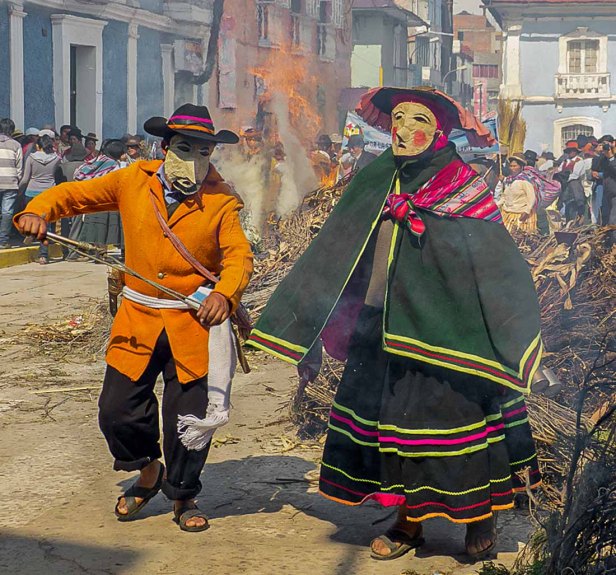
All around the square each group makes its own special ritual around their fire. A lot of beer drinking is going on. Every drinker from time to time splashes beer onto the ground to honour Pachamama the Earth Mother. And this is just the beginning.
Each year, high in the Andes in Puno, Peru, the Festival of the Virgin of Candelaria takes place during the first two weeks of February, and rivals Rio de Janeiro’s Carnival in size, scope and brilliance. The sheer size of Candelaria is staggering: fifty thousand dancers and fifteen thousand musicians. And in an astonishing piece of good luck we get press credentials giving us “front row seats” to all of it.
On the first Sunday in February a dance competition is held at the stadium. These are the dances of the people from the villages and are called autoctonas. There are about one hundred different groups with anywhere from one hundred to three or four hundred dancers and musicians in each group. Covering an entire football field, it’s a joyous riot of colour, and movement, and flying feet.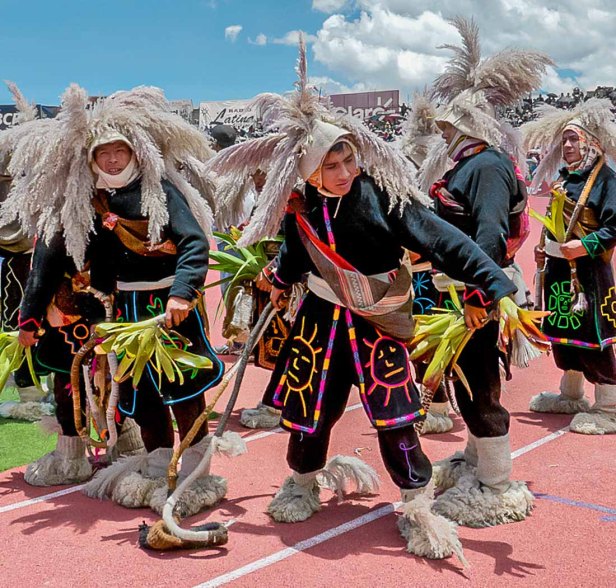


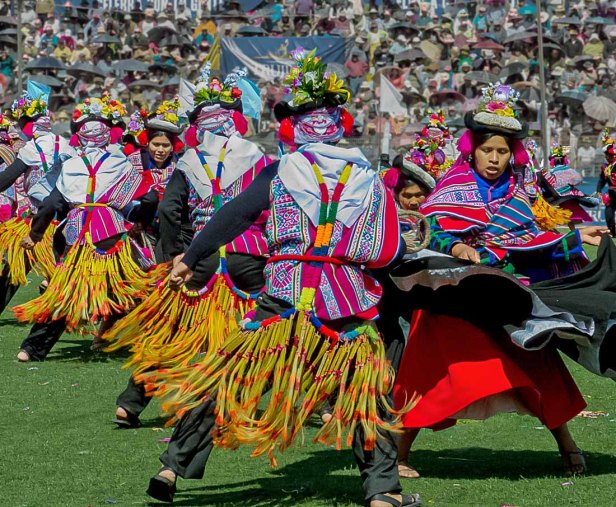
Then they parade – dancing – through the streets of the town. For hours.
During the week there’s always something happening, from impromptu street parties to spectacular fireworks displays. We just follow the music.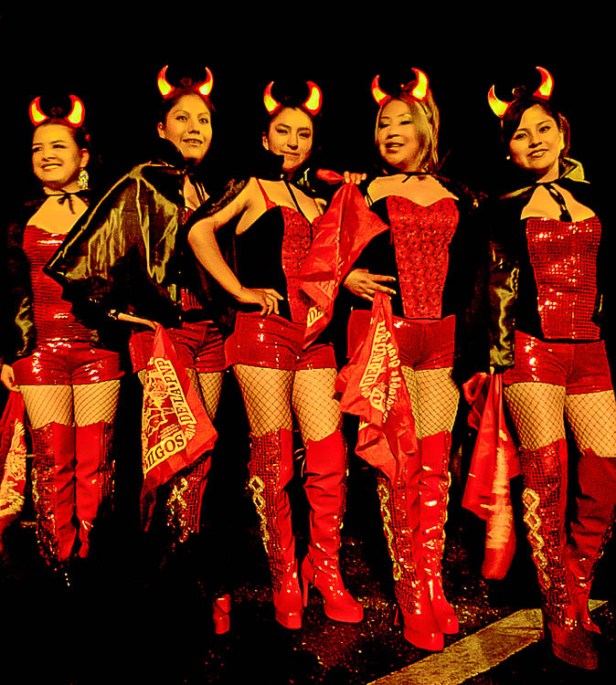
The core of Fiesta Candelaria is the music and dance festival and competition. On the second Sunday it’s the turn of the dance groups from the various neighbourhoods of Puno. These dances are called traje de luces, or suit of lights, and are essentially an expression of the history and spiritual practices of the Mestizo people of the Andes: dances related to fertility, sowing and harvesting, mining activities, the black slave community, the Spanish Conquistadores, and most important of all the Diablada or devil dance: a fight between good and evil that arose from the rescue of some trapped miners who prayed tirelessly to the Virgin of Candelaria.
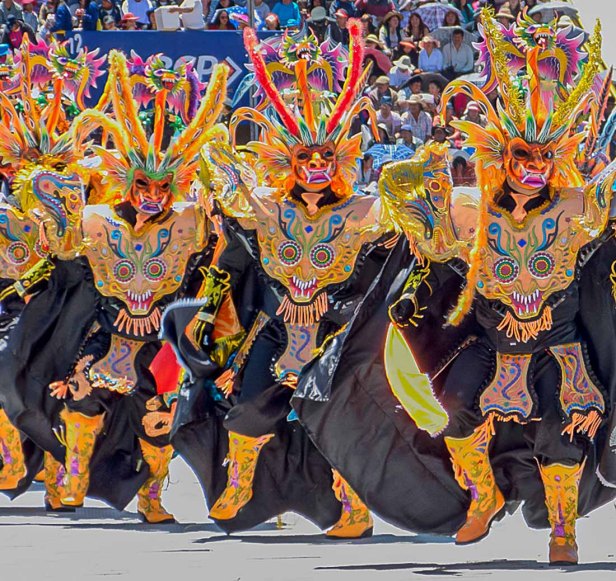
There are eighty different dance groups. Almost every group has its own 50-member brass band. Every group has four to five hundred dancers. The sheer size, scope and colour of it all is truly mind boggling. Imagine this – a football field filled with 500 dancers, half of them men dressed in shiny brightly-coloured suits, and half women dressed in high heels, perky little hats, next-to-nothing skirts, and enough glitter and sequins to light a city, all 500 of them dancing in carefully choreographed patterns at a hundred miles an hour. Breathtaking!
Because there hasn’t already been enough dancing and parading and blowing of trumpets and pipes, on the Monday after the second Sunday of the dance competition there is a parade through the streets of Puno.


Every group participates, drinking beer along the way, energized by the raucous crowds. It is truly epic!
For two weeks every February (pre-pandemic, and presumably post) the festival of the Virgin of Candelaria is held in Puno, Peru. It’s one of the best events we’ve been to. You can read more about it in these three posts.
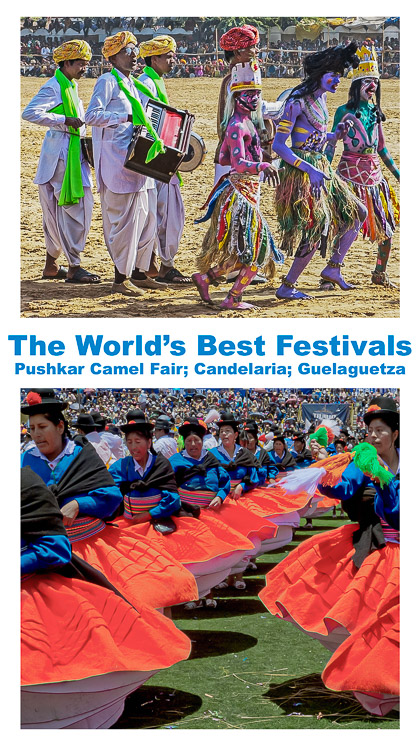
Next post: pushing out of our comfort zone – tubing and kayaking in the Cowichan Valley.
All words and images by Alison Louise Armstrong unless otherwise noted
© Alison Louise Armstrong and Adventures in Wonderland – a pilgrimage of the heart, 2010-2021.

You’ve seen such beauty together … and I really feel you see and are in touch with the spaces and places you travel to… dancing seems so fun right now I’m yearning movement and the colours… the camels are also finished beautifully Alison … haven’t been to these places yet 💛💚🤍🕊hugs hedy 💫
LikeLiked by 2 people
Thanks so much Hedy 🙏 I’m so very curious when I travel. It’s gotten me into trouble at times. Worth it 😂. The dancing at these festivals was just extraordinary. And soooo much fun. A lot of smiling was happening 😄
hugs back 🤗
Alison xo
LikeLiked by 1 person
I love how, despite our different cultural backgrounds, humans find colors attractive, and we incorporate this penchant for anything colorful in our festivals and traditional ceremonies. I can imagine how profound the pandemic has affected those fiestas you mentioned here. But I’m also sure when this is over — or at least under a lot more control — people will return to donning those pretty and extravagant costumes, celebrating everything beautiful about life.
LikeLiked by 2 people
Aren’t the costumes amazing!!! ❤️❤️❤️ I almost think that all the colour is just about my favourite part. Or the dancing. Or both lol 😂
Even festivals I’ve not been to, but have seen photos of, there seems to be a love of elaborate costumes and bright colours. I love it. I hope they can all resume because I agree, they do celebrate everything beautiful about life. Festivals like this are all about the best humanity has to offer 🥰
Alison
LikeLiked by 1 person
Your life Alison, capturing beauty. So beautiful. I loved number three the most, feet not touching ground.
LikeLiked by 1 person
Thank you so much Cindy. 🙏 I must admit I’m much more drawn to the pretty than the gritty.
Number three – Candelaria – we found out about by accident and changed plans to get to it. So glad we did. The size, scope, colour, professionalism, joy – truly epic.
Alison 💕
LikeLike
Wonderful!
LikeLiked by 2 people
Thanks so much Beth 🙏 I’m glad you enjoyed it.
Alison
LikeLiked by 1 person
Oh wow, love all the colour.
LikeLiked by 1 person
Thanks Peggy, me too!
Alison
LikeLike
All so different from each other! I would likely enjoy the camel fair the most; for some reason all that folkloric dancing only keeps my interest for a limited time, and the crowds would make me antsy. But you guys!… you are the fiesta mavens, and I love that about you! In fact, your willingness to immerse yourself in these fairs is a great window for me into these events that I might not be able to handle in person. So, thanks! 🙂 🙂 🙂
LikeLiked by 1 person
Thanks Lexie, and you’re welcome! I love these kinds of festivals. I guess that’s obvious 😂
The camel fair is really pretty amazing – a window into both Ragasthani life, and Hindu rituals, plus some traditional temple dancing and a whole lot more thrown in. At all three festivals our accommodation was a good 15 mins walk from the action so we were able to pace ourselves and get away from it when we needed to.
Alison
LikeLiked by 1 person
Such beautiful dances and rich cultural backgrounds! Love it!
LikeLiked by 1 person
Thanks so much winterose. There is so much tradition and storytelling packed into these festivals – it’s so good that it’s being kept alive.
Alison
LikeLike
Thank you, beautiful pictures.
LikeLiked by 1 person
Thank you so much 🙏 You’re welcome.
Alison
LikeLike
The costumes are incredible, Alison. It is hard to imagine all the work that goes into them. And to have them all swirling and dancing and marching and playing music,,, What fun. And then you wrote about the $50,000 camel! Sounds like a new Ford 150. Thanks for the fun and beauty. –Curt
LikeLiked by 1 person
You’re welcome Curt. Yes indeed, the costumes are amazing. Apparently at Candelaria there are about 25,000 people involved in the behind-the-scenes stuff, including costume construction, most of them absolutely exquisite. Some of the detailed embroidery must have taken months!
In the desert a camel pretty much is a Ford 150 😂
Alison
LikeLike
Right you are about the Camel being a desert F-150. 🙂 Complete with four wheel (paw) drive.
LikeLiked by 1 person
😂 😄
LikeLiked by 1 person
Mind-blowing photography! Bravo!
LikeLiked by 1 person
Thank you so much! 🙏
Alison 💕
LikeLike
The first thing that stands out for me in this post is the amazing colour of all the festivals. Amazing! I soooo badly want to get to Pushkar and have it coincide with the Camel Festival. The pandemic foiled our 2020 trip. When I see the dates for this year, just weeks away, it makes me so excited. Dare I hope for 2022?
Did you know about all these festivals beforehand and plan your dates around them?
LikeLiked by 1 person
I’m a bit of a magpie when it comes to bright colours, and it’s often bright colours that will attract me to take a photo so you can imagine how I was at these festivals, especially Guelaguetza and Candelaria. I was swooning over the colours!
I knew you’d planned to be in Pushkar and had to cancel because of the the pandemic 😢 Fingers crossed for you for 2022!
Frequently when planning a trip one of the first things I research is festivals so we knew about Guelaguetza (and bought our stadium tickets about 6 weeks prior – and thank goodness we did or we’d not have gotten seats) and we knew about Pushkar, and again were glad we’d booked accommodation ahead of time. We stumbled into Candelaria. We were in Puno to go to Lake Titicaca and every night I heard music and went out to see a group of people dancing in the streets. That’s when I learned that Candelaria would be happening in about a month and we immediately changed plans to be there for it.
Alison
LikeLiked by 1 person
I love that you seek out festivals!
LikeLiked by 1 person
How wonderful that people continue these traditions! And how lucky you’ve been to have been there. The photo of the woman in Oaxaca (whose floral wreath matched her dress) is stunning!
LikeLiked by 1 person
Thanks so much 🙏 All three festivals were a bit of a photographer’s dream that’s for sure. I always look for the cultural festivals when we’re travelling – they seem to take you into another dimension of a culture, and yes, how wonderful that they continue, and how lucky we are to have been able to attend a few. They’re one of my fave things about travelling.
The woman with the floral wreath is from a Mexican indigenous group of the Oaxacan Isthmo and are the group after which Frida Khalo styled her dress. Their outfits are stunning.
Alison
LikeLike
What a fun and colorful read!! I am headed to Oaxaca in December for the first time. Not when the festival is being held but I am really looking forward to learning about this culture of this region. Maybe I can get to the festival in the future.
LikeLiked by 1 person
Thanks so much Laureen. Oaxaca is quite wonderful. It has the highest concentration of indigenous groups of any state of Mexico, so there’s a great richness of experience there. Try to get to some of the villages. It can be a cultural feast. Have a great time!
Alison
LikeLike
I thought it was amazing that so many of these are in South America! They do know how to party there, I guess!
LikeLiked by 1 person
They sure do know how to party in South Americas – Candelaria is also a big festival in Bolivia, and of course there’s Carnival in Rio, and if you’re counting Mexico there’s also Fiesta Grande de Enero in Chiapa de Corzo that we went to and is also spectacular. Plus Inti Raymi in Cusco, etc etc. I could happily travel the world just going from one cultural festival to the next.
Alison
LikeLike
These festivals are all amazing. Your pictures reflect the excitement and pageantry and I feel like I am experiencing them through your eyes. Spain has some wonderful festivals as well. It is so easy to get caught up in the festivities.
LikeLiked by 1 person
Thanks so much Darlene. I’m glad I could capture something of the atmosphere. All three festivals were really exciting.
I can imagine Spain has spectacular festivals! One of these days I’ll get to experience some of the European festivals – I keep seeing pictures and would love to go. I’d like to do a world festival crawl 😂
Alison
LikeLike
I love the closeups you did of people and costumes in Oaxaca. It’s interesting to see the contrast between the Mexican and Indian festivals, one in the clear mountain air and the other in the desert. THen the Puno festival – wow! This post oozes energy and color, what a treat!
LikeLiked by 1 person
Thanks so much Lynn. Oaxaca and Pushkar, and the surrounding countryside, couldn’t be more different, nor the lifestyle of the people that live there. And the purpose behind these two festivals is quite different: Oaxaca is about preserving cultural heritage while Pushkar above all else is basically a livestock market deliberately coinciding with some Hindu rituals. Take about different! But both equally exciting. As for Candelaria it was extraordinary, as you say oozing colour and energy. And huge! Easily rivalling Rio’s carnival in size yet most people have never heard of it. Thank goodness out hotel was a distance from the festivities so we could escape when we needed to!
Alison
LikeLiked by 1 person
Those are excellent points about the difference between the festivals. I can imagine the need to take a break from all the excitement and regroup, especially when you’re getting into the middle of it the way you do, and not just keeping yourself on the sidelines.
LikeLiked by 1 person
Such a beautiful diverse set of festivals. The Guelaguetza Festival in Oaxaca is one I’ve dreamt about going and your description of how the dancers don’t walk, they dance is perfect. There is something special with Mexican celebrations that keep a smile on my face well after they have finished. But it was your third introduction that has me most inspired: Candelaria in Punto. Peru has really captured my imagination and I wish to return again and again. Your photos and description of events just solidified this as my goal 🙂 Cheers and wonderful post.
LikeLiked by 1 person
Thanks so much Randall. Guelaguetza is pretty amazing, and definitely worth going to, but Candelaria, yeah, it’s truly epic. I hope you get to it one day. But a word of warning – you cannot see the the dancing in the stadium very well without a press pass. We found it ridiculously easy to get one and I strongly encourage you to do so too if you ever do get there. Read this post for the story of how we got them: https://alisonanddon.com/2014/03/17/this-nomadic-life-four-miracles/
The Candelaria office is very near the main square. Just ask around and someone will direct you to it. Tell them you’re a periodista. It really was that simple.
Alison
LikeLike
🙂 These are the little pieces of advice that make travel that much more special 🙂 Thank you very much, Alison, this would be something very special. So much to see and do, makes every day interesting. Cheers to a great week ahead.
LikeLiked by 1 person
You’re welcome! Hope it happens for you.
A.
LikeLike
This is superb, Alison. Your enthusiasm and excitement just about leaps off the screen. And the eye-popping colors in all three festivals are glorious, as is the seemingly endless dancing at Candelaria and Guelaguetza. I think this is the kind of experience I miss the most since the pandemic hit – not so much the act of traveling itself but being part of such large-scale celebrations of life.
The craziest and most colorful festival I’ve been to is Las Fallas in Valencia, Spain. Imagine firecrackers large and small going off in the streets for days, nightly street parties (with plenty of beer, wine, and deep-fried pastries) and fireworks displays over the center of town. Each neighborhood competes to build the highest and most elaborate papier-mâché sculpture (often in excess of 20 meters) in the plazas and larger intersections; all are eventually set alight as a grand finale. There’s some religious ritual too – over the final two days a giant wooden statue of the Virgin Mary and Child outside the cathedral is given a gorgeous dress of red, white, and pink carnations made from the offerings of residents in traditional clothes. I loved it so much I went twice in as many years.
LikeLiked by 1 person
Thanks so much James. I love festivals. I guess it’s obvious 😂 And the colours! They get me every time. Like you I miss these kinds of gatherings where cultures and life are celebrated.
Las Fallas sounds amazing – just the kind of thing I’d love. OMG I googled it! Wow! I really want to go. I totally get why you went twice. I’m putting it on the list.
Alison
LikeLiked by 1 person
How fun to celebrate all over again these festivals by writing about them! It’s a beautiful autumn day here in Tulsa, but for a while I was in completely different worlds with your post. Fabulous pictures, as always – almost too much to take in from a single post!
LikeLiked by 1 person
Thanks Felicity – glad you enjoyed the pics, and being transported! I loved going back over these festivals – each really was a highlight for us. Magic!
Alison
LikeLike
Wow, each of these is truly fabulous! You’ve captured the excitement, color, energy, and diversity of events for each so beautifully. And they are each so different yet indicative of their culture. How exciting to be there. Thanks for a great post!
LikeLiked by 1 person
Thanks so much Ruth. It was incredibly exciting – at all of them. The energy at something like that is pretty astonishing, and so contagious. I’m glad you enjoyed the post.
Alison
LikeLiked by 1 person
“For ten days we were immersed in the dancing.” TEN?!?! I imagine the intensity and pace remained the same the entire time. You must have been exhilarated and exhausted by the time it ended!
LikeLiked by 1 person
Definitely! Exhilarated and exhausted both. All three of these competitions we were there for the better part of 2 weeks. We learned how to pace ourselves pretty quickly! And to cherry-pick what we’d attend. There was no way to see everything for sure.
Alison
LikeLike
Very colorful post on local festivals. Have been to Pushkar camel festival in the desert long back.It’s such a wholesome experience and the photography is so lively and amazing. Wonderful post really enjoyed reading it!
LikeLiked by 1 person
Thanks so much Puloma. I’m so glad you enjoyed it. We loved the Pushkar festival – well you know what it’s like, so authentic and enriching.
Alison
LikeLike
Wow ‼️ this is awesome
LikeLiked by 1 person
Thank you so much 🙏
LikeLiked by 1 person
Alison, your photos are so incredibly gorgeous and colorful they make me want to travel again so much! You are an extremely talented photographer and I am also so in awe of all your beautiful posts. Wow!
LikeLiked by 1 person
Thanks so much Nicole for all your lovely words. Blogging has made me want to be a better photographer and a better writer. It’s been an amazing journey so far.
I want to travel again so much too! 😢
Alison
LikeLike
I love a festival, and these look like some of the best!! Love your photos as always, they really bring your words to life!
LikeLike
Thanks so much Mo. These three were absolutely some of the best and I’d recommend them to anyone.
About a week after I published this post I suddenly thought of Kurayami Festival. I couldn’t believe I’d forgotten it. Of all of them I think Kurayami was the most powerful for me. I was literally trembling with excitement. That has never happened before. So in the future I’ll do a travel highlights post just about Japanese festivals. In my 2 visits to Japan totalling 33 days I went to 9 festivals!
Alison
LikeLiked by 1 person